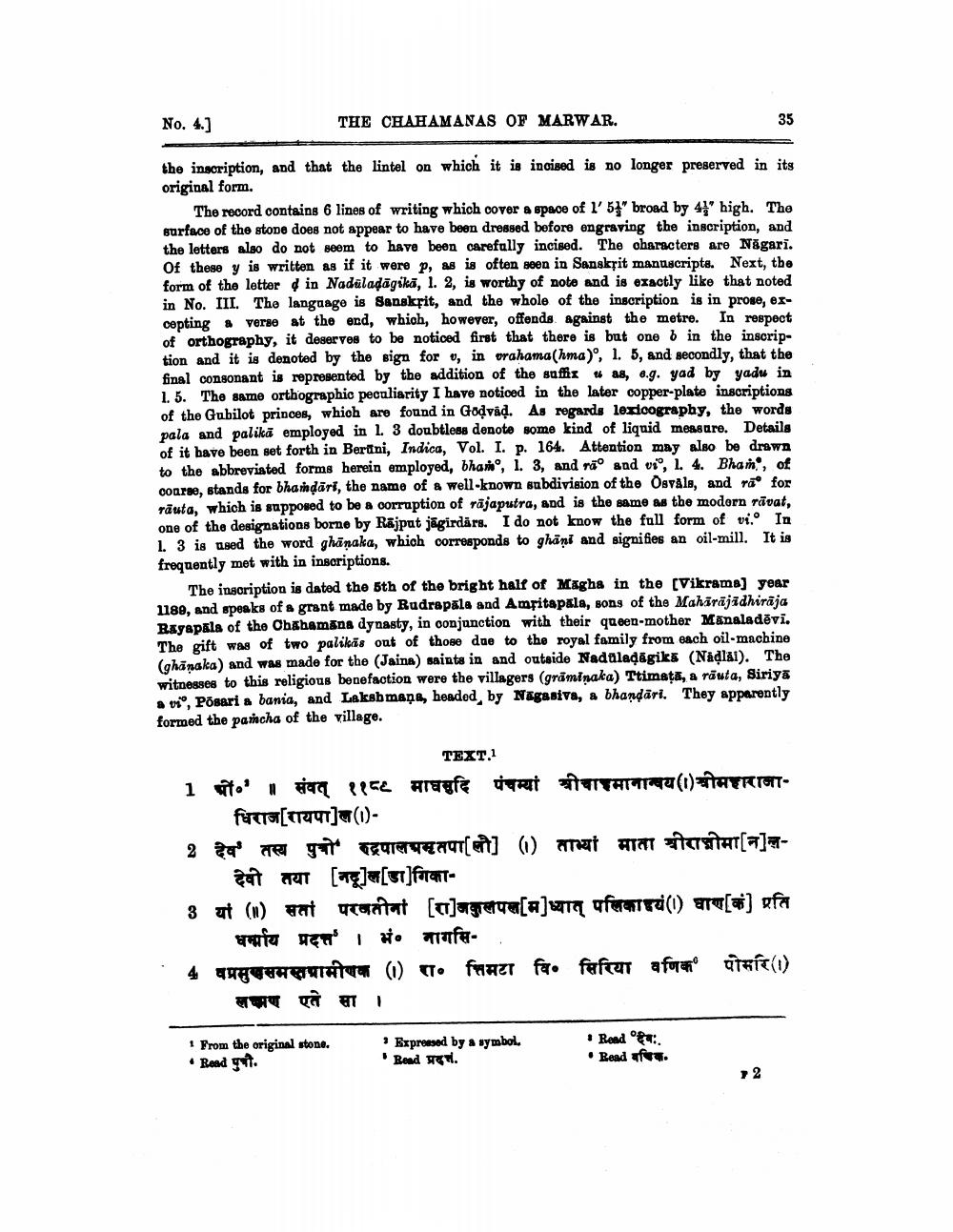________________
No. 4.]
THE CHAHAMANAS OF MARWAR.
the inscription, and that the lintel on which it is incised is no longer preserved in its original form.
The record contains 6 lines of writing which cover a space of l' 53" broad by 41 high. The surface of the stone does not appear to have been dressed before engraving the inscription, and the letters also do not seem to have been carefully incised. The characters are Nagari. Of these y is written as if it were p, as is often seen in Sanskrit manuscripte. Next, the form of the letter & in Naduladägikā, 1. 2, is worthy of note and is exactly like that noted in No. III. The language is Sanskrit, and the whole of the inscription is in prose, ercepting & verse at the end, which, however, offends against the metre. In respect of orthography, it deserves to be noticed first that there is but one b in the inscription and it is denoted by the sign for u, in vrahama(hma), l. 5, and secondly, that the final consonant is represented by the addition of the suffis as, 6.g. yad by yadu in 1. 5. The same orthographic peculiarity I have noticed in the later copper-plate inscriptions of the Gubilot princes, which are found in Godvad. As regards lexicography, the words pala and palikā employed in l. 3 doubtless denote some kind of liquid measure. Details of it bave been set forth in Bertini, Indica, Vol. I. p. 164. Attention may also be drawn to the abbreviated forms herein employed, bhan, 1 3, and não and vi', 1. 4. Bhan, of course, stands for bhaidāri, the name of a well-known subdivision of the Osvals, and rao for răuta, which is supposed to be a corruption of rajaputra, and is the same as the modern rāvat, one of the designations borno by Rājput jāgirdārs. I do not know the full form of vi. In 1. 3 is used the word ghanaka, which corresponds to ghani and signifies an oil-mill. It is frequently met with in inscriptions.
The inscription is dated the 5th of the bright half of Maghs in the (Vikrams] year 1189, and speaks of a grant made by Rudrapala and Amritapala, sons of the Mahäräjidhiraja Bagapals of the Chabam na dynasty, in conjunction with their queen-mother Manaladēvi. The gift was of two palikis out of those dae to the royal family from each oil-machine (ghanaka) and was made for the (Jaina) saints in and outside Nadaladägiks (Nadal). The witnesses to this religious benefaction were the villagers (graminaka) Ttimata, a ranta, Siriya
, PÕBari a bania, and Laksmana, headed, by Nagasiva, a bhandāri. They apparently formed the pancha of the village.
TEXT.1 1 मो० ॥ संवत् १९८८ माघसुदि पंचम्यां श्रीचापमानान्वय()बीमहाराजा.
FOTO [TUT]w(1)2 re got uren ENT] (1) mat ATM CIUTAT [7]7
Ten [ae][ET]forait3 of (N) Fat Troritat [u]agretva[A]wa ufundi(l) 97[*] efa
wafa HER I He info 4 eura (1) To FHAZT fere faftur aforro utif (1)
सकाण एते सा ।
1 From the original stone. • Read yet.
* Expressed by a symbol • Bad प्रदान
. Rond ec. • Read अधिक.




